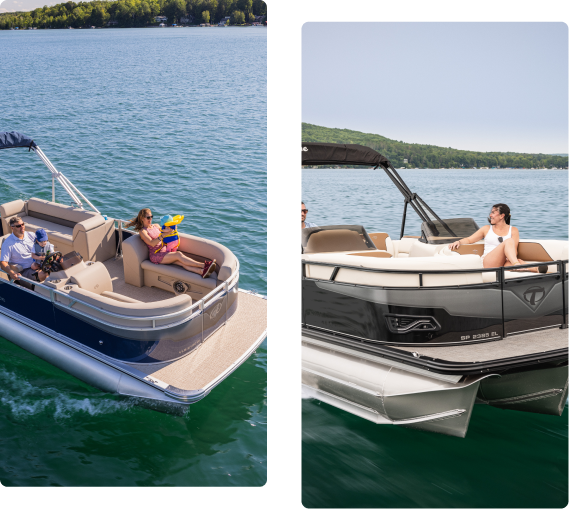Whether you’re a first-time buyer or looking to upgrade, navigating the world of pontoon boats can be daunting. But don’t worry – we’ve got you covered with this guide that will take you through the pontoon buying journey step by step.
Before diving into the pontoon market, it’s crucial to clearly define your needs, be it a fish finder for prime angling or underseat storage compartments for exclusive stow. This step will guide your entire buying process, ensuring you find the perfect match for your lifestyle.
How many people will typically be on board?
Are you planning on fishing, watersports, leisurely cruising, or entertaining?
Will you use it on calm lakes, rivers with currents, or coastal waters?
Weekend outings or daily adventures?
Do you have marina access or need an (optional) trailer?
What are your must-haves? (e.g., built-in coolers or changing rooms in certain lounges, premium sound systems, or seat back compartments)
How might your requirements change in the coming years?

Establishing a realistic budget is crucial when buying a pontoon. You can also look into exclusive special financing or cardholder discounts through a boat club card, paying attention to rate and fee information and important disclosures. It’s not just about the sticker price – consider these key financial factors:
Remember to leave room for unexpected expenses, and always choose quality construction that will last the years. For those considering aluminum pontoons, it’s important to account for their durability and lower maintenance costs, like cleaning aluminum pontoons, which can positively impact your long-term budget.
By understanding the full financial picture, you can confidently pursue a pontoon that fits both your needs and your wallet.
With your needs defined and budget set, it’s time to explore pontoon models and brands. This research is crucial for making an informed decision.
Investigate reputable manufacturers like Bennington, Sun Tracker, Harris, and Avalon. Consider their history, customer satisfaction, and warranty offerings.
Look at fishing pontoons, luxury cruisers, family-friendly options, and performance models. Compare seating layouts, storage, engine power, and build quality.
Check boating forums, manufacturer websites, and independent review sites for real-world experiences from owners.
Seek professional opinions from boating magazines and YouTube channels dedicated to boat reviews.
Virtually “build” your ideal pontoon to understand pricing and options.
Some brands and models hold their value better than others.
Create a comparison chart of your top choices, including key features, prices, pros, and cons. This research will give you confidence as you move forward in your buying journey.

Embark on 50 years of award-winning pontoon excellence with Avalon. Elevate your journey through unrivaled artistry, cutting-edge design, and supreme quality and service.

Never buy a pontoon without thoroughly testing and inspecting it. This crucial step ensures you’re getting the right boat for your needs:
A thorough test drive and inspection can reveal the perfect match or save you from a costly mistake. Take your time and trust your instincts during this crucial step.
Pontoons serve as an investment in countless future memories on the water. For instance, cleaning pontoons is an essential aspect of maintenance that ensures your boat stays in top condition for years to come. Learn more on how to clean pontoons.

Whether you’re looking forward to peaceful fishing trips, exhilarating water sports, or relaxing sunset cruises, your new pontoon boat will be the vessel for these experiences.
Journey with Avalon: Pioneering 5 Decades of Unmatched Pontoon Luxury. Where Art, Quality, and Service Converge for Your Ultimate Water Adventure.
Copyright © 2024 Avalon Pontoon Boats. All Rights Reserved. Sitemap
Copyright © 2022 Avalon Pontoon Boats. All Rights Reserved. Sitemap
One of our Pontoon specialist or a local dealer near you will contact you to help configure the boat that matches your exact needs.
Thank you for taking the time to contact us with your questions and concerns. We love being available for you electronically. Recently, though, we have begun to receive duplicate emails sent to multiple people in the company. In an effort to increase our efficiency and improve our customer service, we would appreciate it if you use our online contact us form to the right so we can automatically direct your request to the correct people on our team.
If you are in need of service regarding a warranty, please contact your dealer (find your local dealer here). Contact us only if your dealer’s service does not meet your needs.
Thank you,
The Avalon Team
903 Michigan Avenue,
Alma, MI 48801